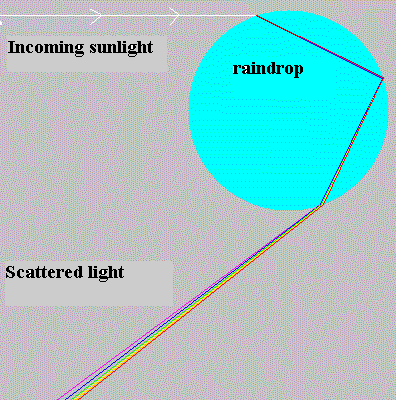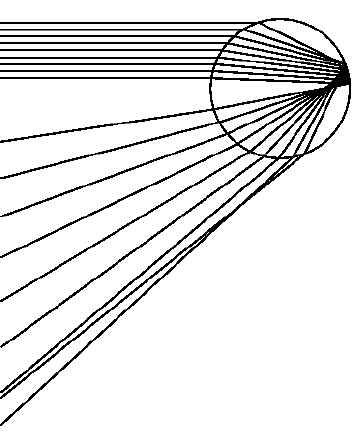
A rainbow comes upon us by surprise, most of the time. They are not
really rare, but they are short-lived, and you have to know when and where
to look.

Rainbows occur in nature when a beam of light interacts with many drops of water. Both reflection and refraction of the light play an important role in their formation. Many different things can happen to the light on its way through a typical drop, but most of these just give light redirected in all directions. The rainbow originates in the special case when a beam of light enters a drop (instead of being reflected away from the drop at its surface), is reflected once inside (instead of leaving at first opportunity through the back surface of the drop), and then finally leaves when it encounters the drop's surface for the third time.
(This picture comes from a simulation
by Sadahisa Kamikawa, which you might like to play with).
The direction of the scattered light depends on how the beam strikes
the raindrop. The picture below shows a spherical drop encountering parallel
beams of light. The important points to see in the picture are that all
 beams are sent back to the left, that many of them are
going nearly the same direction (compare the directions of the beams
that leave near the bottom left corner), and that none of them
are scattered more
widely than this. All of these
beams are reflected more or less backwards, so that to see them we should
be looking away from the sun; we might expect to see a bright glow in that
direction. But the interesting feature is that most of the beams that hit
the upper side of the
drop are scattered in almost exactly the same direction -- about 42
o away from the direction back to the sun.
This means that when you look at an array of many drops, you will only
see the ones that are 42 o away from the shadow of our
head. This defines a
ring of light, centered on the point where the shadow of your head would
be, and having a radius of 42 degrees.
The size of this ring
depends slightly on the color of the light, so that the "red" ring is inside
the "blue" ring.
Usually we can only see the part of the rainbow ring that
is above the horizon, because we need lots of water drops in every direction
that we will see it. We are told that from an airplane you can sometimes
see the complete ring.
beams are sent back to the left, that many of them are
going nearly the same direction (compare the directions of the beams
that leave near the bottom left corner), and that none of them
are scattered more
widely than this. All of these
beams are reflected more or less backwards, so that to see them we should
be looking away from the sun; we might expect to see a bright glow in that
direction. But the interesting feature is that most of the beams that hit
the upper side of the
drop are scattered in almost exactly the same direction -- about 42
o away from the direction back to the sun.
This means that when you look at an array of many drops, you will only
see the ones that are 42 o away from the shadow of our
head. This defines a
ring of light, centered on the point where the shadow of your head would
be, and having a radius of 42 degrees.
The size of this ring
depends slightly on the color of the light, so that the "red" ring is inside
the "blue" ring.
Usually we can only see the part of the rainbow ring that
is above the horizon, because we need lots of water drops in every direction
that we will see it. We are told that from an airplane you can sometimes
see the complete ring.
From this description, we can deduce the important conditions for seeing
a rainbow.

Rainbows are to admire and enjoy -- you can't put them in a jar, and they are hard to photograph, because they are not really much brighter than the sky.
Cumberland Falls, near Corbin and London, KY, provides a nice example
of a rainbow at a waterfall.
This waterfall faces north, and makes a lot
of mist; in the morning there is a very vivid rainbow to be seen from the
viewing area at the east side.
Even more interesting is what happens in
the early evening on days near the full moon: now the moon is rising in
the east, and is bright enough to give a "moonbow."
It is too dim for your
color vision to work well, so that it seems more like a colorless (that
is, white) arc.
This phenomenon is quite rare -- it requires a lot of mist
(to give lots of scattered light of the right kind), but not too much (which
would just give you a white cloud to look at); it has to face the right
way; and it's surely very important that Cumberland Falls is
a state park, with no
street lights behind the moonbow.
prisms and lenses